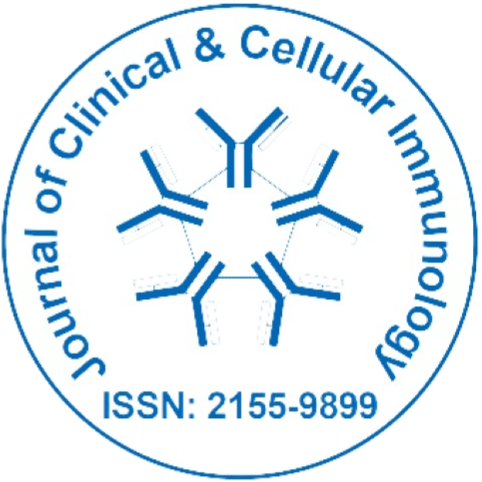
Journal of Clinical and Cellular Immunology
Open Access
ISSN: 2155-9899

ISSN: 2155-9899
Perspective - (2025)Volume 16, Issue 2
The immune system is a highly dynamic network of cells and molecules that together maintain tissue homeostasis and protect the body against infection, injury, and malignancy. For decades, immunology has centered on the functions of well-characterized immune cells T cells, B cells, macrophages, neutrophils, and dendritic cells. Yet, mounting evidence suggests that this classical view captures only part of the immune landscape. In recent years, researchers have uncovered a diverse array of “non-canonical” immune cells and immune-like functions in unexpected cellular populations. These include unconventional lymphocytes, tissue-resident stromal cells, epithelial and endothelial cells, and immune cells with atypical or context-dependent roles. Together, these discoveries are reshaping our understanding of how immune responses are orchestrated and how diseases are modulated.
Non-canonical immune cells challenge traditional definitions. They often straddle the line between immune and non-immune identity, performing hybrid functions such as tissue repair, metabolic regulation, and immunosuppression. Moreover, they influence disease processes in ways that can be both protective and pathogenic. Recognizing their roles is critical for developing targeted therapies that can modulate the immune system more precisely.
Non-canonical immune pathways and inflammasome biology
Beyond their role in host defense, non-canonical inflammasomes have been implicated in diverse pathological contexts. In autoimmune disorders such as lupus and rheumatoid arthritis, aberrant activation of these pathways can drive persistent inflammation and tissue damage. Conversely, under certain conditions, non-canonical inflammasome activation can promote pathogen clearance or limit uncontrolled cytokine release, suggesting a nuanced role in balancing immunity and tolerance.
In cancer biology, this duality is equally apparent. Non-canonical inflammasome activation can induce tumor cell death and enhance antitumor immunity, yet chronic inflammasome activity may also foster a pro-inflammatory microenvironment that supports tumor progression. For instance, in pancreatic and colorectal cancers, the modulation of caspase-11-dependent pyroptosis can either sensitize tumor cells to therapy or exacerbate inflammation that promotes metastasis. These observations underscore the context-dependent nature of non-canonical immune signaling.
Beyond inflammasomes, alternative branches of well-known signaling networks further illustrate the complexity of immune regulation. In diseases such as inflammatory bowel disease or multiple sclerosis, dysregulation of this pathway contributes to long-term tissue remodeling and immune persistence.
Taken together, these non-canonical signaling routes act as modulatory layers fine-tuning the intensity, duration, and quality of immune responses. They provide insight into why patients with the same disease often exhibit divergent inflammatory profiles and therapeutic outcomes. By studying these mechanisms, researchers hope to identify new therapeutic targets that selectively adjust immune activation without compromising systemic defense.
Non-immune and stromal cells as active immune modulators
Another emerging paradigm is that many non-immune cells possess intrinsic immunological capabilities. Tissues once considered merely structural or metabolic now appear to play active roles in shaping immune responses. Epithelial, endothelial, and stromal cells, for example, express pattern recognition receptors, secrete cytokines, and present antigens under specific conditions.
Epithelial cells at barrier surfaces such as the gut, skin, and lungs serve as first responders to microbial and environmental cues. They produce antimicrobial peptides, chemokines, and alarmins that recruit immune cells and coordinate tissue repair. In diseases like inflammatory bowel disease and chronic obstructive pulmonary disease, dysregulation of epithelial immune functions leads to pathological inflammation and impaired regeneration.
Fibroblasts and stromal cells, once thought of purely as structural scaffolds, have also emerged as potent immune regulators. In the tumor microenvironment, for instance, cancer-associated fibroblasts release immunosuppressive mediators that hinder cytotoxic T-cell activity while promoting regulatory T-cell expansion. In autoimmune arthritis, synovial fibroblasts perpetuate inflammation through persistent cytokine production and antigen presentation. Similarly, cardiac fibroblasts and vascular smooth muscle cells can acquire immune-like properties after injury, contributing to fibrosis and chronic inflammation.
Endothelial cells, which line the vasculature, likewise function as immune sentinels. They respond to cytokines, express adhesion molecules, and regulate leukocyte trafficking into tissues. In conditions such as atherosclerosis and vasculitis, their non-canonical immune activation shapes the local inflammatory milieu and influences disease progression.
Beyond these structural cells, immune cell plasticity adds another layer of complexity. Macrophages, T cells, and dendritic cells can adopt atypical phenotypes that diverge from their canonical functions. For instance, macrophages may assume tissue-repairing or metabolic states independent of their classical M1/M2 polarization, while certain dendritic cell subsets promote tolerance rather than activation. Even innate Lymphoid Cells (ILCs) exhibit remarkable flexibility, shifting between inflammatory and regulatory states in response to microenvironmental cues.
These findings highlight a more integrated view of immunity one that blurs the boundaries between immune and non-immune compartments. Disease outcomes, in this light, depend not solely on immune cell infiltration but also on how local tissues interpret and respond to immune stimuli.
Ultimately, appreciating the contributions of non-canonical immune cells transforms our concept of immunity. The immune system is not confined to discrete cellular populations but operates as a distributed network, where every tissue can act as an immune organ under stress or injury. By uncovering how these non-traditional immune players modulate disease, researchers and clinicians move closer to a new generation of precision immunotherapies ones that harness the full spectrum of the body’s defense mechanisms while maintaining the delicate equilibrium of health.
Citation: Christina A (2025). Emerging Roles of Non-Canonical Immune Cells in Disease Modulation. J Clin Cell Immunol. 16:755
Received: 22-May-2025, Manuscript No. JCCI-25-38847 ; Editor assigned: 26-May-2025, Pre QC No. JCCI-25-38847 (PQ); Reviewed: 09-Jun-2025, QC No. JCCI-25-38847 ; Revised: 16-Jun-2025, Manuscript No. JCCI-25-38847 (R); Published: 23-Jun-2025 , DOI: 10.35248/2155-9899.25.16.755
Copyright: © 2025 Christina A. This is an open-access article distributed under the terms of the Creative Commons Attribution License, which permits unrestricted use, distribution, and reproduction in any medium, provided the original author and source are credited.